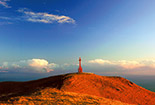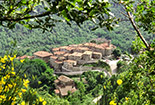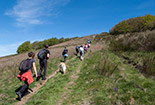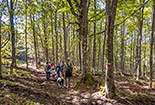To the great cross with snow
A walk in Pratomagno accompanied by the warm light of the sunset
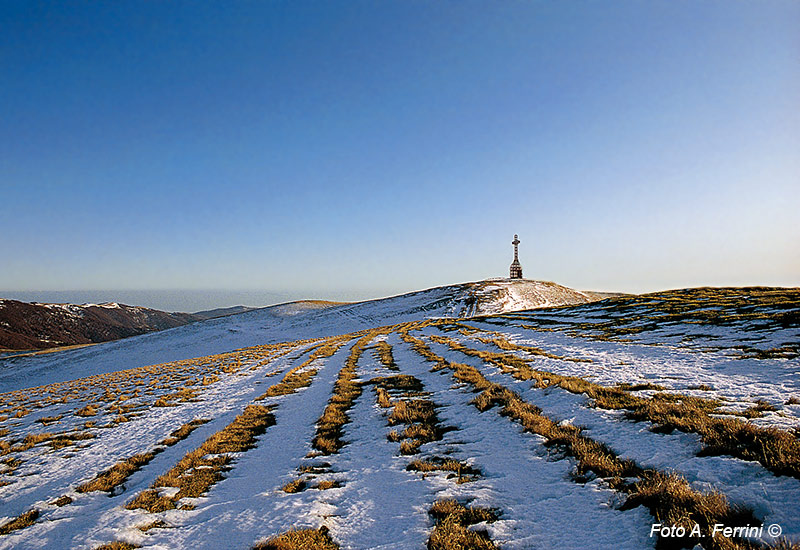
Texts and photos by Alessandro Ferrini ©
35 images in sequence to get to know this path on the snow in Pratomagno illuminated by the light of the sunset
Walk in the snow to the Hinkler memorial stone and the Pratomagno cross
 The itinerary described in these pages is one of the three shortest and least tiring routes to get to the Hinkler memorial stone and the Pratomagno cross, symbol of this mountain and geographical reference because it is clearly visible from a large part of the Casentino and Valdarno. This path, about six hundred meters longer than the other two, is certainly the most interesting because it takes us through a beautiful beech forest and then gives us a clear idea of the conformation of the Pratomagno massif. At the end of this text we will also briefly describe the other two itineraries.
It is a path that requires very little physical effort. It has a length of about two kilometers (one way) and has a positive difference in height of two hundred meters. For the return we will use the same path, we will certainly have the opportunity to observe things and views not seen on the way out.
The starting point of this short excursion is the square in front of the Da Giocondo restaurant, 1.5 kilometers before the tunnel that allows the paved road that climbs from the Casentino to cross the massif and begin its descent towards the Valdarno.
For this trek we will use the HR route (Hinkler Ring). A little over halfway, the path overlaps the CAI 00 on the Pratomagno ridge. The start of the walk is in the restaurant square, exactly between the two driveways. The asphalted road, on the right, which climbs towards the previously mentioned tunnel and the dirt road, on the left, which in one kilometer leads to the equipped area Le 3 Fonti. In the first five hundred meters the HR route crosses a beautiful beech forest, we are climbing on the Poggio delle Portacce. Then the wood begins to thin out, leaving space for clearings that offer the first views: over the Casentino, to the left and behind us; on the southern part of the Pratomagno massif, towards the south. A few hundred meters more and we arrive at the highest point of Poggio delle Portacce marked by a tuft of beech trees to the right of the path. From here the panorama becomes much wider and more interesting. In addition to what we saw above, we can see the entire Pratomagno mountain north of the cross, up to Monte Secchieta, unmistakable for the presence of three large wind turbines.
The itinerary described in these pages is one of the three shortest and least tiring routes to get to the Hinkler memorial stone and the Pratomagno cross, symbol of this mountain and geographical reference because it is clearly visible from a large part of the Casentino and Valdarno. This path, about six hundred meters longer than the other two, is certainly the most interesting because it takes us through a beautiful beech forest and then gives us a clear idea of the conformation of the Pratomagno massif. At the end of this text we will also briefly describe the other two itineraries.
It is a path that requires very little physical effort. It has a length of about two kilometers (one way) and has a positive difference in height of two hundred meters. For the return we will use the same path, we will certainly have the opportunity to observe things and views not seen on the way out.
The starting point of this short excursion is the square in front of the Da Giocondo restaurant, 1.5 kilometers before the tunnel that allows the paved road that climbs from the Casentino to cross the massif and begin its descent towards the Valdarno.
For this trek we will use the HR route (Hinkler Ring). A little over halfway, the path overlaps the CAI 00 on the Pratomagno ridge. The start of the walk is in the restaurant square, exactly between the two driveways. The asphalted road, on the right, which climbs towards the previously mentioned tunnel and the dirt road, on the left, which in one kilometer leads to the equipped area Le 3 Fonti. In the first five hundred meters the HR route crosses a beautiful beech forest, we are climbing on the Poggio delle Portacce. Then the wood begins to thin out, leaving space for clearings that offer the first views: over the Casentino, to the left and behind us; on the southern part of the Pratomagno massif, towards the south. A few hundred meters more and we arrive at the highest point of Poggio delle Portacce marked by a tuft of beech trees to the right of the path. From here the panorama becomes much wider and more interesting. In addition to what we saw above, we can see the entire Pratomagno mountain north of the cross, up to Monte Secchieta, unmistakable for the presence of three large wind turbines. On the horizon, towards the north west, we see the jagged profile of the Apuan Alps. On the opposite side, however, behind Monte della Verna, we distinguish the plateaus of Sasso Simone and Simoncello. A little further to the right you can see the Sibillini Mountains.
The most demanding part of the route is over. Continuing to climb, in a few minutes we will reach Poggio Pianellaccio (1594 m) where the memorial stone dedicated to Hinkler, the Australian aviator who crashed on this mountain in January 1933 is located. From here, in another ten minutes we will arrive at the great cross (1592 m).
Pratomagno is beautiful in any season, at any time of day. There are moments, however, in which it offers unusual choreographies, colors that are sometimes strong, other times delicate, however capable of moving us. To follow the itinerary described above, we chose a particular environmental and light situation: with snow and in the last part of the day. From this mix he generated an incredible landscape. The thirty-five images that illustrate this walk, therefore, in addition to suggesting an interesting itinerary on the mountain, generally traveled in the summer, want to show us what shows the Pratomagno can offer us. We started our trek accompanied by cold light, typical in shaded areas with clear skies. Going up we found the direct rays of a sun now low on the horizon, therefore a grazing light capable of shaping even the smallest volume. Then, after a few minutes, a light haze filtered the sunlight, making it first yellow, then orange. Thus, our walk was enveloped in a light that became more and more incandescent. On the way back, the sun has completely set, so the walk ended in the twilight of the forest and with a very cold light again.
We said at the beginning of this text that the one just described is one of the three short and easy itineraries to reach Poggio Pianellaccio and the Pratomagno cross. To follow another itinerary, the more well-known one and which involves less physical effort, you have
On the horizon, towards the north west, we see the jagged profile of the Apuan Alps. On the opposite side, however, behind Monte della Verna, we distinguish the plateaus of Sasso Simone and Simoncello. A little further to the right you can see the Sibillini Mountains.
The most demanding part of the route is over. Continuing to climb, in a few minutes we will reach Poggio Pianellaccio (1594 m) where the memorial stone dedicated to Hinkler, the Australian aviator who crashed on this mountain in January 1933 is located. From here, in another ten minutes we will arrive at the great cross (1592 m).
Pratomagno is beautiful in any season, at any time of day. There are moments, however, in which it offers unusual choreographies, colors that are sometimes strong, other times delicate, however capable of moving us. To follow the itinerary described above, we chose a particular environmental and light situation: with snow and in the last part of the day. From this mix he generated an incredible landscape. The thirty-five images that illustrate this walk, therefore, in addition to suggesting an interesting itinerary on the mountain, generally traveled in the summer, want to show us what shows the Pratomagno can offer us. We started our trek accompanied by cold light, typical in shaded areas with clear skies. Going up we found the direct rays of a sun now low on the horizon, therefore a grazing light capable of shaping even the smallest volume. Then, after a few minutes, a light haze filtered the sunlight, making it first yellow, then orange. Thus, our walk was enveloped in a light that became more and more incandescent. On the way back, the sun has completely set, so the walk ended in the twilight of the forest and with a very cold light again.
We said at the beginning of this text that the one just described is one of the three short and easy itineraries to reach Poggio Pianellaccio and the Pratomagno cross. To follow another itinerary, the more well-known one and which involves less physical effort, you have to reach the 3 Fonti car park and equipped area by car. We are at 1450 meters, here the walk begins. We begin to climb the service road closed by a bar that corresponds to CAI 42B. We reach the ridge of the mountain between Poggio delle Portacce, which we recognize on our right for the unmistakable tuft of beech trees, and Poggio Pianellaccio. Here we turn left and the HR path, which after a few meters overlaps the CAI 00, leads us to the Hinkler memorial stone, then to the cross.
If we want to use the third short itinerary to go up to Poggio Pianellaccio and the Pratomagno cross, we have to drive to the tunnel. To the left of this, for those coming from the Casentino, there is a steep but short path that takes us up the mountain ridge (1460 meters), a low point because we are at Varco ai Gioghi. Here we find the CAI 00 which we take to the left. At the beginning the climb is not very demanding, then it becomes bristly, but for a short distance. We will reach the intersection with the HR path that connects Poggio delle Portacce with Poggio Piannellacio. A few meters below, on the opposite side, CAI 49B arrives. We turn right, the climb is no longer challenging. In a few minutes we reach Hinkler's memorial stone, then, another ten minutes of walking and we arrive at the cross.
To reach this area of Pratomagno from the Casentino, the road passes next to the small village of Quota which originated from a medieval castle. If from the Colle della Croce del Pratomagno or from Poggio Pianellaccio we observe the Valdarno slopes of the mountain, we see two villages: they are Trappola and Rocca Ricciarda. These too were medieval castles and fortresses. To learn more about these fascinating places click on the banners below.
to reach the 3 Fonti car park and equipped area by car. We are at 1450 meters, here the walk begins. We begin to climb the service road closed by a bar that corresponds to CAI 42B. We reach the ridge of the mountain between Poggio delle Portacce, which we recognize on our right for the unmistakable tuft of beech trees, and Poggio Pianellaccio. Here we turn left and the HR path, which after a few meters overlaps the CAI 00, leads us to the Hinkler memorial stone, then to the cross.
If we want to use the third short itinerary to go up to Poggio Pianellaccio and the Pratomagno cross, we have to drive to the tunnel. To the left of this, for those coming from the Casentino, there is a steep but short path that takes us up the mountain ridge (1460 meters), a low point because we are at Varco ai Gioghi. Here we find the CAI 00 which we take to the left. At the beginning the climb is not very demanding, then it becomes bristly, but for a short distance. We will reach the intersection with the HR path that connects Poggio delle Portacce with Poggio Piannellacio. A few meters below, on the opposite side, CAI 49B arrives. We turn right, the climb is no longer challenging. In a few minutes we reach Hinkler's memorial stone, then, another ten minutes of walking and we arrive at the cross.
To reach this area of Pratomagno from the Casentino, the road passes next to the small village of Quota which originated from a medieval castle. If from the Colle della Croce del Pratomagno or from Poggio Pianellaccio we observe the Valdarno slopes of the mountain, we see two villages: they are Trappola and Rocca Ricciarda. These too were medieval castles and fortresses. To learn more about these fascinating places click on the banners below.



